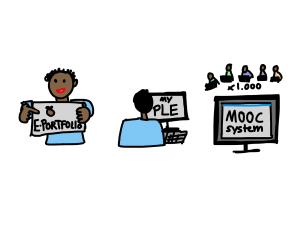
For the fourth topic we decided to take an example of the real world, a MOOC. It sounded really good and it is quit an interesting topic. As well we can support a colleague. So let´s start with our consulting team.
It seems to be very easy to create a MOOC. But as you look more closely you will find out that a lot of decisions have to be made and a lot of topics has to be considered.
It starts with the fact that there are different MOOCs. So, with which format would you like to proceed? It is as well essential to address an educational problem and to design the course at the beginning. Therefore, the target group has to be described and also the learning content and the teaching goals. This addresses the WHAT in the framework model of Heimann (Kerres, 2018). But there is as well a HOW to approach. You have to decide which method you are using (exploratory or expository) and which media is useful, beside deciding on the learning organisation. So, you have to choose an LMS on which you are running the course, and you have to look in detail to find the right platform that fits your needs. Therefore Baumgartner et al. (2002) can help you to identify the right one with giving you categories that you may take into account.
But you have to produce as well videos and you have to provide tasks. Moreover, if there are thousands of learners taking part it is quite difficult to deliver support as it is quite expensive. Therefore, we discussed gamification that should engage the learners as MOOCs are often used by many but not concluded by a lot of learners. But there are as well other elements such as the assessment that has to be addressed. In which way to you provide it? And of course, learners should get a certificate after the completion of the course.
So, the task seemed to be quite simple at the beginning, but along the way it became obvious that the creation of a MOOC is quite complex and I guess as well challenging as you have to consider a lot of different elements and you have to bring them together. Other requirements that come to my mind are e.g., the technical support, maybe the enrollment of the learners, the selection of a video server, the video production, the tool you should use for it and so on. In the group we had a lot of ideas too.
In conclusion I would like to add that it was quite interesting to be engaged in topic 4 with a real project as well it is challenging to provide activity in a MOOC for thousands of students. Maybe interactive videos are another option.
Additionally, I would like to mention that the lecture of Dr. Robin Kay was excellent. So, I was very enthusiastic in participating in designing a MOOC and it is a little bit sad that the MOOC continues without us taking part in the further development.
References:
Baumgartner, P., Häfele, H., & Maier-Häfele, K. (2002): E-Learning Praxishandbuch: Auswahl von Lernplattformen; Marktübersicht Funktionen Fachbegriffe. Innsbruck
Kerres, M. (2018). Mediendidaktik: Konzeption und Entwicklung digitaler Lernangebote (5. Aufl.). Berlin/Boston: Walter de Gruyter
Leave a Reply to Lars Harrysson Cancel reply